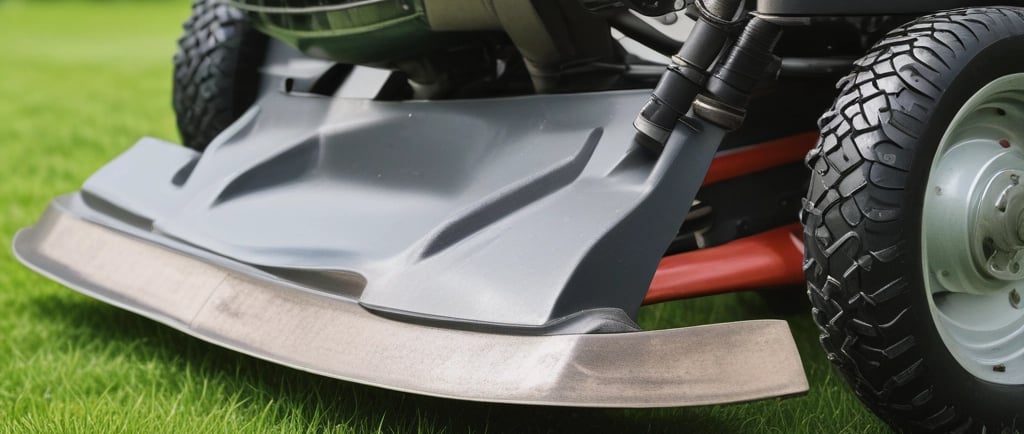A Comprehensive Guide to Replacing a Husqvarna Mower Blade
HUSQVARNA GE
10/24/20255 min read


Understanding the Importance of a Sharp Mower Blade
Maintaining a sharp mower blade is essential for achieving optimal lawn health and enhancing mower performance. When the mower blade is sharp, it makes clean cuts through the grass, resulting in neat and healthy grass blades. In contrast, a dull blade tears through the grass, leading to ragged edges that can weaken the grass and predispose it to diseases and pests. This tearing effect creates openings for pathogens, affecting the overall vigor of the lawn.
Moreover, when grass is cut cleanly, it promotes healthier growth. Grass that is regularly maintained with a sharp blade recovers more quickly, leading to a denser, greener lawn. The clean cuts ensure that grass blades retain moisture and nutrients more effectively, promoting robust growth and reducing the need for excessive watering and fertilization.
Additionally, regular blade maintenance contributes to a mower's cutting efficiency. A sharp blade requires less power from the mower's engine, which means it can operate at optimal performance levels without unnecessary strain. This efficiency helps extend the life of the mower while reducing wear and tear on its components. In fact, a well-maintained blade can significantly decrease fuel consumption, proving cost-effective over time for homeowners tending to their lawns.
Furthermore, the visual appeal of your lawn is greatly enhanced when a sharp mower blade is utilized. Lawns that are mowed with a sharp blade exhibit a cleaner, more manicured appearance, elevating the aesthetics of one's yard. Regularly sharpening or replacing the mower blade is a small yet impactful maintenance task that ensures the health and beauty of your lawn throughout the growing season.
Tools and Materials Needed for Blade Replacement
When it comes to replacing the mower blade on your Husqvarna lawn mower, having the right tools and materials is essential to ensure a safe and efficient process. Start with basic hand tools including a socket wrench or ratchet set, which will be necessary for loosening and tightening the bolts securing the blade. A torque wrench may also be beneficial, as it allows for precise tightening according to the manufacturer's specifications, ensuring optimal performance of the mower.
In addition to these tools, a flathead screwdriver can assist in prying off any debris trapped around the blade area during maintenance. It is important to wear safety gloves to protect your hands while handling sharp blades, as well as safety goggles to shield your eyes from flying debris. For added safety, a sturdy workbench or a pair of jack stands will stabilize the mower during the blade replacement process.
When selecting a replacement blade, make sure to choose one specifically designed for Husqvarna mowers. These blades can usually be purchased from authorized Husqvarna dealers, home improvement stores, or online retailers that specialize in lawn equipment parts. Be aware of the size and model of your mower to ensure compatibility with the replacement blade. It is also advisable to consider purchasing mulching blades, which are designed for efficient grass cutting and nutrient recycling.
Additional materials like lubricants, such as WD-40 or vegetable oil, can be useful for easing any tough bolts or cleaning the area before installation. Cleaning supplies, including a cloth or brush, will help remove grass clippings and debris that may have accumulated around the mower deck and blade. By gathering these essential tools and materials, you will set yourself up for a successful blade replacement on your Husqvarna mower.
Step-by-Step Instructions for Replacing the Mower Blade
Replacing the blade on a Husqvarna mower involves several critical steps to ensure safety and effectiveness. Following these instructions will help you execute the task smoothly. Begin by ensuring you are wearing safety gloves and goggles to protect yourself from sharp edges and debris.
Before starting, disconnect the spark plug from the mower. This precaution is essential to prevent accidental starting during the blade replacement process. After ensuring that the mower is turned off and unplugged, proceed to raise it using a mower lift or jack. If neither is available, park the mower on a flat surface and tilt it carefully to one side. Ensure that the air filter side is facing upwards to avoid oil leakage.
Once the mower is elevated, you can access the lawn mower blade. Locate the blade assembly, which is typically secured by a central bolt. If you encounter difficulty loosening a stubborn bolt, consider applying penetrating oil to help ease the process. Utilize a socket wrench to turn the bolt counterclockwise, ensuring to provide steady pressure.
With the old blade detached, examine the blade mount to ensure it is in good condition. If necessary, clean the area to remove any grass clippings or debris. Take the new mower blade and align it with the bolt holes. Secure it by hand initially before tightening the bolt with the socket wrench. It is crucial to ensure the new blade is mounted in the correct orientation, with the cutting edges facing downwards.
Finally, reattach the spark plug to restore power to the mower. Perform a visual inspection before starting the mower to ensure everything is securely tightened and that no tools are left behind. Following these steps will help you successfully replace the mower blade, ensuring optimal performance during your next mowing session.
Maintaining Your New Mower Blade for Longevity
To maximize the lifespan and efficiency of your new Husqvarna mower blade, regular maintenance is critical. Implementing preventive measures will not only extend the blade's life but also ensure superior performance during mowing. One of the most crucial tasks is sharpening the blade frequently. A sharp blade cuts grass more cleanly, promoting healthier lawn growth and reducing stress on the mower.
It is advisable to check the sharpness of the mower blade after every 5-10 hours of use. Depending on the terrain and density of the grass, you may need to sharpen it more frequently for optimal results. When sharpening, ensure to create a consistent angle similar to the factory edge, as this will aid in efficient cutting. Investing in a quality sharpening tool specifically designed for mower blades can simplify this process and yield professional results.
Cleaning your mower blade post-use is another essential step in maintenance. Grass clippings and debris can accumulate, leading to rust and corrosion. After each mowing session, take the time to clean the blade with a putty knife or a wire brush. This simple practice helps avert damaging elements and ensures a clean-cut when you next mow. Additionally, applying a light coat of oil after cleaning can further protect against rust.
Proper storage of the mower during off-seasons contributes significantly to the longevity of the mower blade. Store the mower in a dry, sheltered location to protect it from outdoor elements. If possible, elevate the mower to grind off moisture buildup, which can accelerate rust formation. Keeping the blade covered in a storage container will also minimize exposure to dust and humidity.
Establishing a routine for mower maintenance, including sharpening, cleaning, and proper storage, will enhance the durability and performance of your Husqvarna mower blade. A proactive approach will not only save you time and money in the long run but also keep your grass looking its best.
